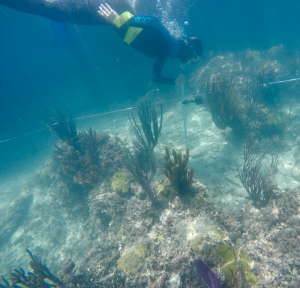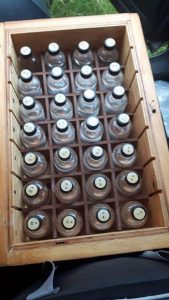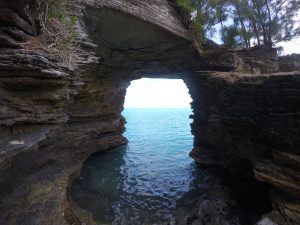It was Wednesday, the final round of my second day of water sampling, when I hit a bump in the road with the rolling cooler I was pulling behind me. The second cooler of water samples, which had been stacked on top, toppled to the asphalt. Eight ice packs and 54 water sample bottles careened out of the cooler and across the road.

This, I thought to myself, throwing my hands up in the air like a cartoon character, is absurd. I scooped the samples up from the pavement, picking a few out from the grassy verge where they’d fallen, and shoved them back into the cooler (carefully packing ice back over the top). I reminded myself, as I have often these past six weeks: This is science.
I’m in Bermuda for two months this summer, studying how polluted groundwater discharge is affecting near-shore coral reefs. The field season has been exciting, fulfilling, challenging, and full of slightly ridiculous situations. I’ve gone swimming along the reef like an aquatic Gandalf, carrying a camera mounted on a PVC stick. I’ve attached equipment to the reef by looping zip-ties through holes in the rocks, and so have spent hours poking these zip-ties into crevasses and attempting to pull them through on the opposite side.

The most challenging aspect of my fieldwork is water sampling. Water samples are the foundation of the rest of my project’s ecological analyses, but the collection process poses a number of hurdles. I’m studying three different reefs, and comparing the impact of groundwater discharge on their water quality and ecology. Normally water quality samples are collected from the smooth, clean decks of big oceangoing vessels. Yet the reefs I’m studying are too shallow for a boat to cross, so I’m instead sampling from shore: hopping in from the rocky coastline, swimming out over the reef to each sample location, and rinsing and filling a collection bottle at the sea bottom. I then swim back to shore and sit on the rocks to filter the seawater into sample bottles.
In order to control for the tidal and day-to-day variation in groundwater discharge rates, I am staggering my sample collection: I collect water from one site, and then move to the next one, and then the third, before returning to each site again for a second, and then a third, round of sampling. Last week, I was in and out of the water nine times and (with the help of a very generous friend) filtered and poured samples into 84 separate, pre-labeled, pre-washed and triple-rinsed bottles. The process takes about twelve hours, and requires more-or-less nonstop sampling. This is how last Wednesday I ended up power-walking down the road with two coolers, and one incredibly dedicated friend, in tow. This is also, of course, how I ended up picking sample bottles out of the grass verge.

The impediments to collecting water samples on these shallow coastal reefs are part of why these reefs haven’t been sampled extensively before – and, in my opinion, why it’s so important to study them now. Other studies of Bermuda’s coastline have failed to detect groundwater discharge, while my samples last summer clearly showed its presence. The logistical constraints of my project – sampling from shore, and focusing on one sample site – allowed me to detect groundwater where larger-scale studies had missed it. One small victory for small-scale undergraduate research!

It is especially in the most absurd moments – crouched in a shoreline cave, over a mat of Casuarina pine needles, an array sample bottles, and a pile of wet snorkel gear – that I remind myself that this indeed is science. Research is about collecting the samples however they can best be collected. It is sometimes small-scale. It is often absurd. And this is good.
– Zoe Sims, Natural Sciences Correspondent

